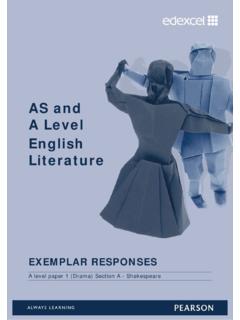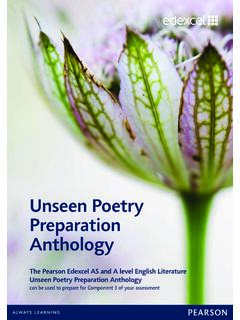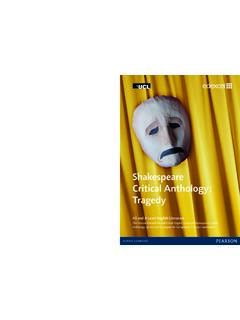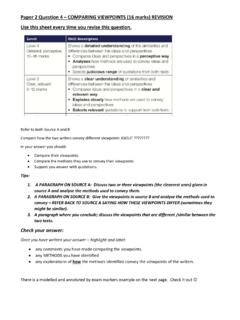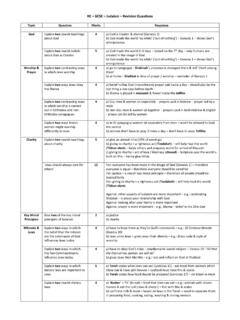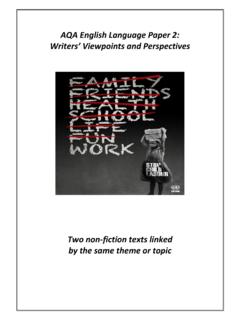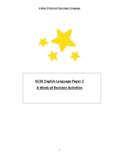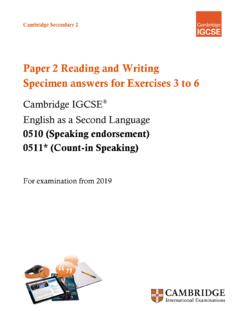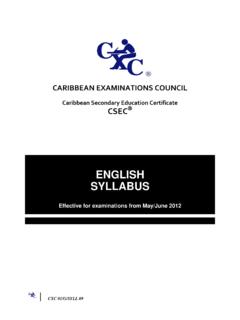Transcription of English Language Paper 2 - Holy Trinity Academy
1 English Language Paper 2 Practise PaperSection A: Friday 2nd December Lesson 1 Section B: Tuesday 6thDecember Lesson 2 English Language Paper 2 (25% of the English Language GCSE)19th, 20th and 21st Century Non Fiction WritingSection A Reading 1 hourSection B Writing 45 minutesContent and skills for Paper 2 Section AWriters viewpoints and perspectives for Paper 2 To develop students insights into how writers have particular viewpoints and perspectives on issues or themes that are important to the way we think and live our lives. Two linked sources from different time periods and genres in order to consider how each presents a perspective or viewpoint to influence the reader. Sources will be drawn from the 19th century, and either the 20th or 21stcenturies depending on the time period selected for Paper 1 in each series. Choice of genre for the sources will be non-fiction and literary non-fiction such as high quality journalism, articles, reports, essays, travel writing, accounts, sketches, letters, diaries, reports, autobiography and biographical passages or other appropriate non-fiction and literary non-fiction Objectives:AO1: Identify and interpret explicit and implicit information and ideas.
2 Select and synthesise evidence from different : Explain, comment on and analyse how writers use Language and structure to achieve effects and influence readers, using relevant subject terminology to support their viewsAO3: Compare writers ideas and perspectives, as well as how these are conveyed, across two or more textsAO4: Evaluate texts critically and support this with appropriate textual references What is AO1?What is the difference between explicit and implicitinformation and ideas?Explicit v/s ImplicitExplicit ideas are obvious and clear to ideas are not as obvious they are often beneath the v/s ImplicitExplicit say what you see!It is a picture what is what is going on beneath the boy looks bored which might suggest draw a table in your book with two columns titled: Explicit and ImplicitExplicit say what you see!Implicit what is say what you see!
3 Implicit what is what does the speaker want?Explicit say what you see!Implicit what is This day is going so slowly can t believe how long is left. I am absolutely desperate for a coffee. According to her letter, what progress does she say has been made so far? AO1 This question is asking you to show you understand what the text is about, and that you can select relevant material from it to show your understanding. You need to explain the subject matter of the letter in your own is the explicit meaning?What is implied? Paper 2 Question 2 See information on next Objectives:AO1: Identify and interpret explicit and implicit information and ideas. Select and synthesise evidence from different textsAO2: Explain, comment on and analyse how writers use Language and structure to achieve effects and influence readers, using relevant subject terminology to support their viewsAO3: Compare writers ideas and perspectives, as well as how these are conveyed, across two or more textsAO4: Evaluate texts critically and support this with appropriate textual referencesPaper 2 Question2 assessesPaper 2: Question 2 summary and synthesis need to refer to Source A and Source B for this details from both sources.
4 Write a summary of the differences in WHATEVER THE TEXTS ARE ABOUT.(8 marks)Skills be assessed:Summary to give the mains points of a text, something that has been blended together from different sources. Q2 Mark schemeQuestion 2 Useful phrasesIn source A we are informed / told source AIn source difference source A, source .. review time! Learnt the difference between EXPLICIT and IMPLICIT meanings. Revised how to write summaries which is selecting the key information, writing it up in your own words with short quotations to support your understanding, picking up on implied / implicit meanings in the text. Synthesising information from the two texts into one overall 2 Question 3 See information on next question:Assessment Objectives:AO1: Identify and interpret explicit and implicit information and ideas. Select and synthesise evidence from different textsAO2: Explain, comment on and analyse how writers use Language and structure to achieve effects and influence readers, using relevant subject terminology to support their viewsAO3: Compare writers ideas and perspectives, as well as how these are conveyed, across two or more textsAO4: Evaluate texts critically and support this with appropriate textual referencesPaper 2 Question3 assessesSee the next slide for an example question 3 response which has been highlighted for the different skills you have to 2 Question 4 See information on next question:Q4 comparing viewpointsand perspectivesin two different 4 basically you have to use the skills of question 2 and question 3!
5 AO3 -Compare writer s ideas and perspectives as well as how these are conveyed, across two or more QuestionKey Learning: Writer s viewpoint / point of view Viewpoint / Point of View refers to the way that a writer think or feels about a topic. This might be explicit, clearly stated by the writer, or implicit, implied by to the tone and Language : annotate your copy of this extract for words / phrases / techniques that tell us what Bryson thinks of Las Vegas and how it makes him Learning: Writer s PerspectivesWriter s perspectives refers to the way that writers might view a topic differently depending on WHEN they are writing. You should expect to see a topic being viewed from two different perspectives: a modern one and a historical Mark schemeRead the two texts you have been given. As you are reading bare the question in mind and annotate if you need to.
6 You will have time to do this after the reading time ParagraphThe two texts give very different views of childhood. The girl in the Victorian text has to work for a living and she s only a year older that Tim Lott s daughter. Mayhew describes the watercress seller as in thoughts and manner, a woman and this tells us that, because of her situation, she has to take on adult responsibilities. On the other hand, the modern child is taken on expensive holidays and looked after very well by her parents. Mayhew shows us that the watercress seller has no concept of normal childish things like going to the park, toys and games in fact she responds to these ideas with amazement and eyes brightened up to show how unfamiliar she is with these parts of what might called a normal childhood. Her life is all about her work; her life is harsh and a normal childhood has been denied her.
7 Whereas the modern child gets attention and care by screaming , the writer says my daughter is an habitual screamer suggesting that she did it often to get attention. The writer seems to accept that this is part of normal childhood as he uses the word habitual but in comparison to the ideas in the other text the modern child seems pampered and less resilient than the watercress : Write your own practise : Select ONE viewpoint from each source that is different. Then write up these two viewpoints, saying how they are different in your own Sentences: Red = viewpoints / perspectives Blue = methods / languageIn source A, the viewpoint of the writer is clearly shown in the aspect to the writer s viewpoint in source A words / phrase / this , in source b the writer s viewpoint for this point of view can be seen in the quotation .. which shows the reader viewpoint in source b is different because it viewpoint is shown in the : Can you make a comment about the different perspectives being displayed by the writer s because of the time they are writing in?
8 What evidence do you have for this? Remember to support your work with quotations from the texts. Embedded quotations are , Differently,Alternatively,The word / phrase / technique implies / suggestsQuestion 4 Markscheme(ideas = viewpoints, the dastardly exam board love to confuse us): English Language Paper 2 Section B: Writing 45 minutesPlease see the next slides for the mark scheme for the writing Practise QuestionsLanguage techniques / methods
